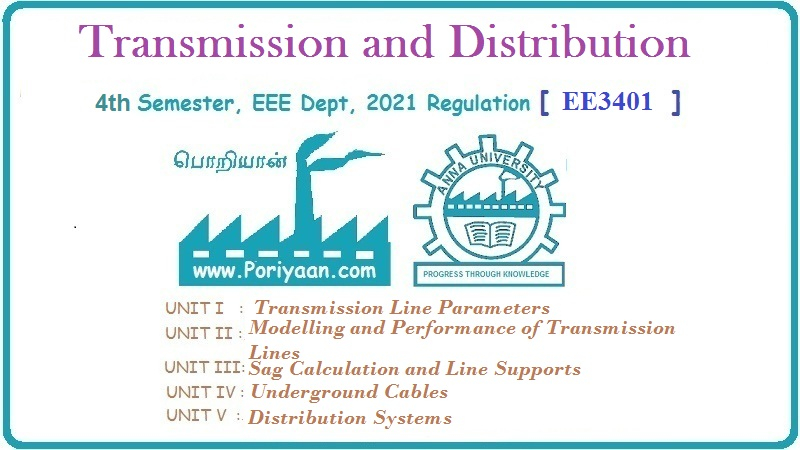Transmission and Distribution: Unit IV: Underground Cables
Insulating Materials for Cables
Properties - Poly Vinyl Chloride (PVC) - Paper - Cross Linked Polythelene - Vulcanised India Rubber (VIR)
Questions : 1. List out the properties of insulating materials used for the cables. 2. List the various insulating materials used for the cables and discuss their features.
Insulating Materials for
Cables
AU: May-12
Number of layers of the various
materials is used around the actual conductor in a cable. To isolate the
conductor from the surroundings, the conductor is provided with an insulation
around it. The materials like paper, vulcanised rubber, PVC etc. are used for
providing such an insulation.
1. Properties of Insulating Materials used for Cables
The material to be used as an insulation
must have the following properties,
1. To prevent leakage current, its insulation
resistance must be very high.
2. To avoid electrical breakdown, its
dielectric strength must be very high.
3. To withstand the mechanical injuries,
it must be mechanically very strong.
4. It should be flexible.
5. It should be non-hygroscopic so that
it will not absorb the moisture from the surroundings.
6. It should be non-inflammable.
7. It should be unaffected by acids and
alkalies.
8. It should be capable of withstanding
high breakdown voltages.
9. It should have high temperature
withstanding capability.
The main insulating materials which are
in use are,
1. Poly Vinyl Chloride (PVC)
2. Paper
3. Cross Linked Polythene
4. Vulcanised India Rubber (VIR)
2. Poly Vinyl Chloride (PVC)
It is thermo plastic synthetic compound.
It is available in the powder form and is obtained from polymerisation of
acetylene. This powder is chemically inert, non-inflammable, odourless,
tasteless and insoluble. It is combined with plastic compound and a gel is used
over the conductor to obtain the insulation.
It has following characteristics,
1. Good dielectric strength of 17 kV/mm
2. Chemically inert.
3. Non-hygroscopic.
4. Resistant to corrosion.
5. Maximum continuous temperature rating
of 75oC.
6. High electrical resistivity.
The mechanical properties like
elasticity of PVC are not as good as rubber so PVC cables are used for low and
medium voltage domestic, industrial lights and power installations.
3. Paper
The paper is very cheap insulating material.
Its dielectric strength is also high but it is hygroscopic in nature. When it
is dry its insulation resistance is very high but a small amount of moisture
reduces its insulation resistance to a very low value. Thus it is impregnated
in an insulating oil. After impregnating also it has a tendency to absorb the
moisture. Hence paper cables are never left unsealed and provided with the
protective covering. When not in use, paper cable ends are temporarily covered
with wax or tar.
The paper has following characteristics,
1. High dielectric strength of 20 kV/mm.
2. Higher thermal conductivity.
3. Low capacitance.
4. High durability.
5. Low cost.
6. Maximum continuous temperature rating
of 80oC.
7. High insulation resistance when dry.
It is used in high voltage power cable
manufacturing. The paper cables are preferred when the cable route has very few
joints and hence generally used for low voltage distribution in thickly
populated areas.
4. Cross Linked Polythelene
The cables using cross linked polythelene
as the insulating material are called XLPE cables.
The low density polythelene is treated
specially due to which there occurs cross linking of carbon atoms in it. This
results into a new material which has following properties,
1. High dielectric strength of 20 to 40
kV/mm
2. Non-inflammable : If at all the
continuous flame is applied its burning stops after very few centimetres away
from the flame.
3. Extremely high melting point.
4. Light in weight and flexible.
5. Mechanically strong.
6. High temperature withstanding
capability.
7. Low moisture absorption.
8. Maximum continuous temperature rating
of 90oC.
XLPE cables are directly laid on soil
bed and are used for the voltages upto and including 33 kV.
5. Vulcanised India Rubber (VIR)
This is the most olden insulating
material developed during 1880-1930. The pure rubber is very soft and it can
not withstand high temperatures hence it is 20 to 40 % of India rubber mixed
with mineral matter such as zinc oxide, red lead etc. with a little bit of sulphur
in it.
It has following characteristics,
1. Good dielectric strength of 15 kV/mm.
2. Good mechanical strength.
3. Durable and wear resistant.
4. Good insulation resistance.
5. Remain more elastic than pure rubber.
But it has number of drawbacks such as,
1. It absorbs moisture, slightly.
2. It has low melting point.
3. The sulphur content attack the copper
conductor and changes the VIR insulation colour. Hence copper conductors to be
used with VIR insulation must be tinned.
4. Short span of life.
The use of VIR is very limited now a
days and is used for low and moderate voltage cables i.e. distribution systems
only.
Review Questions
1. List out the properties of insulating materials used for
the cables.
AU : May – 12,17, Marks 6
2. List the various insulating materials used for the
cables and discuss their features.
AU : Dec– 15, Marks 8
Transmission and Distribution: Unit IV: Underground Cables : Tag: : Properties - Poly Vinyl Chloride (PVC) - Paper - Cross Linked Polythelene - Vulcanised India Rubber (VIR) - Insulating Materials for Cables
Related Topics
Related Subjects
Transmission and Distribution
EE3401 TD 4th Semester EEE Dept | 2021 Regulation | 4th Semester EEE Dept 2021 Regulation
